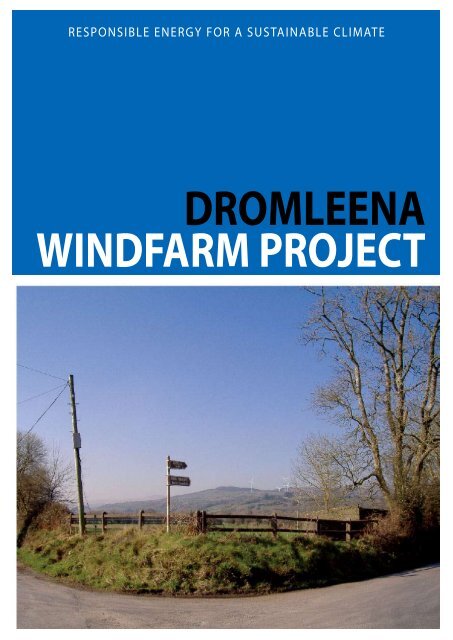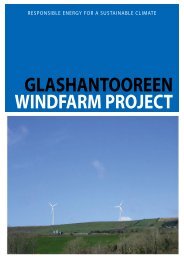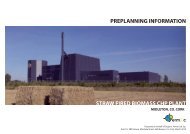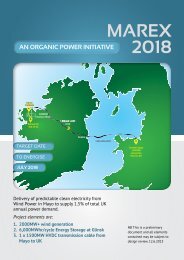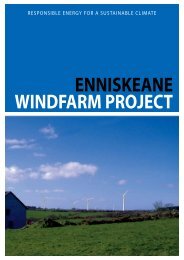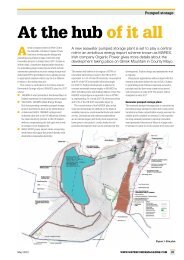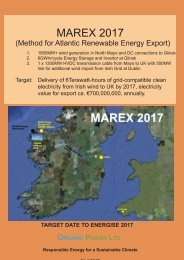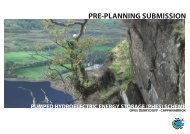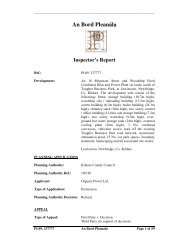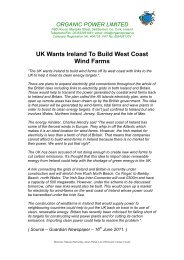DROMLEENA WINDFARM PROJECT - Organic Power
DROMLEENA WINDFARM PROJECT - Organic Power
DROMLEENA WINDFARM PROJECT - Organic Power
- No tags were found...
You also want an ePaper? Increase the reach of your titles
YUMPU automatically turns print PDFs into web optimized ePapers that Google loves.
RESPONSIBLE ENERGY FOR A SUSTAINABLE CLIMATE<strong>DROMLEENA</strong><strong>WINDFARM</strong> <strong>PROJECT</strong>
ContentsProject Overview 3Project Details 4Why do we need renewable energy 7Meeting the challenge 9Frequently asked questions 10Questionnaire 11
<strong>PROJECT</strong> OVERVIEWThe proposed €10.3 million capital cost wind power project at Dromleena is composedof two clusters, covering the following townlands:Cluster 1; 5 turbines, DromleenaCluster 2; 4 turbines, DerrynasafaghThe proposed location of the project is in two townlands to the west of Dunmanway,Co. Cork, specifically the townlands of Dromleena and Derrynasafagh. The project areaconsists mainly of heath. The total land take required for the proposed project is lessthan 2.25% of the study area, which is defined as the site boundaries of the propertiesinvolved in the project. Land use for all turbine bases will be 1290m 2 , and approximately2.9km of new tracks will be required and approximately 500m of upgraded track toprovide access to the turbines.The proposed wind farm is being developed by <strong>Organic</strong> <strong>Power</strong> Ltd., a new renewableenergy company based in Skibbereen, Co. Cork. <strong>Organic</strong> <strong>Power</strong> intend to develop aminimum of 125MW of carbon-free reliable electricity supply from a variety of renewableenergy sources for 2012. This power will be sold to end customers at a competitive rate.3
<strong>PROJECT</strong> DETAILS<strong>Power</strong>• 9 Enercon wind turbines, each with a maximumgenerating capacity of 0.9MW totalling 8.1MWinstalled capacity• Operating efficiency is projected at 37.5% of installedcapacity, or minimum average output of 3.04MW• Enough energy to power the equivalent of 3,325households• Will result in the avoidance of 18,000 tonnes ofCarbon emissions annually• Will contribute 0.675% of the Government’s target of15% of energy coming from renewable source by2015 (1200MW).Construction• Work is planned to commence around early 2011subject to permits, and will be completed in a workperiod around 9 to 12 months spread over 2 years.• The wind farm has an operational life of 30 years.At the end of its life, the turbines will be dismantledand removed from the site or an application will besubmitted to retain or replace the existing wind turbinesSite SelectionThe wind farm site is regarded as a prime solution due toa combination of the following factors:• High wind speed• Close proximity to available grid capacity• Turbines can be sited in compliance with WindIndustry recommendations and Planning requirementswith respect to noise and other environmental factors• Location of turbines near the existing roadsminimises the impact of construction traffic• Impact on internationally and nationallydesignated sites or landscapes are avoided4
Economic BenefitsThe project will, at its peak, provide in excess of 40 jobs during the construction phase. Theconstruction phase will be nine-twelve months spread over two years. At least 1 full time jobwill be created for the operation of the wind farm, and a further 2 full time or equivalent jobsto undertake the maintenance.Landowners leasing land to the project will receive approximately €60,000 per year from theproject. This is equivalent to the creation of 1 full time job in the locality for the duration ofthe wind project. The project will cost up to €10,530,000 to construct, of which, approximately€2,340,000 will be spent on infrastructure including foundations, roads, underground cablingand general building works.It is <strong>Organic</strong> <strong>Power</strong>’s policy to encourage local companies to tender for such work, and itproposes to hold a register of local companies wishing to tender. <strong>Organic</strong> <strong>Power</strong> will liaisewith the local community associations and Business Associations in relation to this. During theoperational phase approximately €117,000 will be spent each year on the general upkeep ofthe wind farm, which will include local employees.<strong>Organic</strong> <strong>Power</strong> is setting up a Community Fund to enable the local community to benefit fromthe operation of the Wind Farm. Approximately €16,000 will be made available each year forfive years for community projects.6
Climate ChangeGlobal climate change is widely recognised as being one of the greatest environmentalchallenges facing the world today. Jean Pascal Van Ypersele of the Intergovernmental Panel ofClimate Change, the globally recognised authority on climate change has stated the followingin May 2007:• Climate Change is happening now, mostly as a result of human activities.• Impacts will be felt everywhere, including cities, with most damages in developing countries.• Together with lifestyle and behaviour changes, known technologies and policies can reduceGreenhouse Gas emissions.• All sectors and regions have the potential to contribute to reductionsSome current examples of negative consequences of global warming are:There is good evidence that the European heat wave of 2003, which resulted in 26,000premature deaths, was influenced by global warming.The numbers of people affected by floods worldwide has risen from seven million in the 1960’sto 150 million today. Sea levels are predicted to rise as a result of global warming, increasingthe suffering caused by local floods. If carbon emissions are stabilised, sea level will rise by0.8m over the next two centuries, if not it could rise by 7m, (23 feet) due to melting of polarand Greenland ice sheets.Long term drought in the Sahel, the land to the south of the Sahara in Africa, has resulted inthe displacement of farmers from Chad, who are colonising land in Darfur, causing the currenthumanitarian crisis there.Tropical storms, cyclones, typhoons, and hurricanes are increasing in frequency, speed offormation, and destructive power, due to increases in sea-surface temperature.Global warming is real, deadly serious, man-made, and the greatest threat to common wellbeing of our time.Why reduce carbon emissions?Climate change due to global warming is, and will be largely related to the atmosphericcontent of Carbon Dioxide and Methane, both of which are emitted at higher than naturallevels by human activities. The scale of the consequences of warming is related directly to thelevels of carbon in the atmosphere.WHY DO WE NEEDRENEWABLE ENERGY?7
Why reduce carbon emissions cont.?The following table shows some examples of the relative consequences of stabilising the carbonlevels by reducing emissions now in order to stabilise levels at 450ppm, leading to an IPCCestimated 2.1 degree (range1.9 to 4.4) temperature increase compared to continuing to increaseemissions 750 ppm leading to an IPCC estimated 4.3 degree (range 2.8-6.4) temperature increase:Examples from ‘Six Degrees’ by George Lynas 2007REDUCED EMISSIONSCONTINUED EMISSIONSSea Level 2300 +0.8m +7m Irish coastal cities drownedSummer temperaturehigh Ireland 2100Winter temperature lowIreland 2100Mediterranean holidayspots 2100Gulf Stream 2100Storms Ireland 210030 degrees C 45 degrees CCattle cannot survive in IrelandNo changeLong cold spells below zeroForests burn in summerMuch reduced, Seawatertemperature 10-15 degrees C15% Increase in number andintensityDesert, no waterStopped, Seawater temperaturebelow 6 degrees CRegular severe hurricane stylestorms and floodsFood 2100 Droughts India, China, Africa Worldwide food shortagesClimate Stability 2100 Stable Self-reinforcing increase intemperatureENERGYEnergy is vital to the modern economy. Ireland is over 90% dependent on imported energy andis heavily reliant on imported oil, gas, and coal. Our small indigenous energy supplies continue todecline. A reliance on imported energy may make us more vulnerable to price fluctuations andinterruptions of supply caused by political instability and conflict in other parts of the world.In the first quarter of 2008 crude oil was trading at over $120/barrel, and is forecast by theAssociation for the Study of Peak Oil to trade at €175 in one year’s time. Currently world oilsupplies are contracting by 3% per year, while demand is increasing by 3% (Mr. Eamonn Ryan TD,Minister for Energy, Communications and Natural Resources, Ireland, Dublin, 24th, July 2007). Thismeans ever less quantity, and ever more expensive oil, our main source of energy in Ireland.Nuclear energy, like oil burning, is also suffering contracting fuel supply due to an impendingshortage of uranium due to the slow pace of uranium extraction, according to nuclear physicistMichael Dittmar of ETH Zurich (September 2007). This means that expanding energy productionfrom nuclear sources will be extremely difficult and costly. Wave power is still, unfortunately, morethan ten years away from commercialisation, so wind power remains Ireland’s most likely solutionfor both energy-supply and global warming problems.8
Renewable energy is playing an essential role in reducing our fossil fuel consumption, therebyreducing the emission of greenhouse gasses.Ireland has a strong wind power resource, relative to other European countries, generallyabove 8.5m/s here, as compared to below 7 for most of the continent. The cost of generatingelectricity from wind has fallen dramatically over the past few years. At present, wind energy isthe most cost effective renewable energy technology available. A mix of wind power with otherrenewable energy sources, such as biomass and Pumped Hydro Energy Storage (PHES), will beneeded to meet Ireland’s challenging targets on sustainable energy and climate change.“Climate change and rising oil prices mean we have to reform the way we consider energyservices. We can look at these challenges in a negative light or we can realise the potentialthat exists for sustainable economic growth that exists. Our aim now is to encourage theenergy industry in Ireland in order to create the jobs of tomorrow. We have industry readyand waiting in the wings to take advantage of this new opportunity. Assisting them inthis process will be a key priority of this Government.” – Eamonn Ryan, Minister for EnergyCommunications and Natural Resources, Ireland, Dublin, 13th July 2007Ireland’s emissions are currently 80 million tonnes CO 2 (MTCO 2 ) per annum. To reducethis to meet agreed targets, we must reduce this by 17 MTCO 2 . The target for renewablescontribution to this reduction is 1.47 MTCO 2 .“Electricity generation from Renewable Sources provides the most effective way of reducingthe contribution of power generation to Ireland’s Greenhouse gas emissions. The governmenthas therefore established ambitious targets for the contribution of renewables to powergeneration; 15% of electricity consumed will be from renewables in 2010 and 33% by 2020.Annual emissions savings of 1.47 MTCO 2 will be achieved on foot of the government’s 15%target for 2010.”–National Climate Change Strategy 2007.The Dromleena wind project will mitigate approximately 18,000 tonnes of CO 2 perannum (based on actual aggregate emissions from the Irish Energy Sector for 2007)– the equivalent of 1.4% of the 2010 government target.MEETING THECHALLENGE9
Public attitudes to wind energyDr Charles Warren of St Andrew’s University School of Geography and Geosciences, Scotlandpublished the findings of a study carried out in 2005the perceptions and experiences of thosewith a wind farm in their ‘backyard’. Several hundred people were interviewed at wind farm sites inthe Scottish Borders and south west Ireland. Interviewees were asked about their reactions to theprospect of wind farms and how they actually reacted when they were put up. Respondents foundno noise issues and regarded wind farms as attractive additions to the landscape.The study uncovered similar attitudes in the Irish counties of Cork and Kerry, where 73% ofrespondents stated that their initial fears about wind farms were not realised. The survey revealedthat people living near proposed wind farm sites were less supportive of the technology thanthose in close proximity to established wind farms. A large majority said their fears about windfarms had failed to transpire. Opponents tended to view the environment as locally conceived andabout protecting their local surroundings.Frequently asked questionsWHO ARE ORGANIC POWER? <strong>Organic</strong> <strong>Power</strong> is a company established in 2006 to develop nonpollutingenergy from a mix of renewable sources. The company favours local participation inshareholding where it has projects.WHERE WILL THE POWER GO? The electricity generated from this project will be deliveredunderground from the turbines to a local substation and onto the national grid which passesthrough some of the townlands for the proposed erection of the turbines.WILL THE TURBINES PRODUCE NUISANCE NOISE? The turbines are sited in such a way to resultin a design noise level of at or below 40 decibels outside houses, which is a noise equivalent ofagricultractor/excavator operating 400 metres away (Damian Brosnan, Noise Consultant 2007).DO THE TURBINES DISTURB ANIMALS? Cattle, sheep, horses and wildlife, quickly becomeaccustomed to wind-farms.DO TURBINES KILL BIRDS? Except when located in migration paths of bird, bird kill from turbines isminimal, and is orders of magnitude less than bird kill arising from overhead cables and vehicles.WILL THERE BE HEALTH IMPACTS FOR LOCAL RESIDENTS? To our knowledge, and that ofSustainable Energy Ireland, the Department of Health, and the Wind Energy Industry, there are nomedically proven health hazards arising from properly designed and operated wind farms.CAN I BUY ELECTRICITY FROM THE TURBINES? Yes, <strong>Organic</strong> <strong>Power</strong> will be selling the power atcompetitive prices, via the existing ESB network.CAN I INVEST IN THE <strong>PROJECT</strong>? Yes, contact Sean Glasgow (+44 (0) 845 652 1789) for details.10
Please circle one answer only1. Do you agree that renewable energy projects can reduce global warming?Strongly Agree Agree No Opinion Disagree Strongly Disagree2. Do you think that a local renewable energy project is a good idea?Strongly Agree Agree No Opinion Disagree Strongly Disagree3. Do you think that a wind farm is compatible with this area?Strongly Agree Agree No Opinion Disagree Strongly Disagree4. Approximately €16,000 euro per year for a period of five years will be provided for acommunity fund from the earnings of the project in which of the following areas would youlike to see this money invested? (Please number in order of preference (1 best preferred, 5 least preferred)local playground facilities.............................broadband infrastructure.............................sports clubs........................................................agricultural charity such as bóthar ...........(insert your own suggestion here)............5. Other Comments<strong>DROMLEENA</strong>QUESTIONNAIREWe appreciate your feedback. Please fill in the above survey and return to:<strong>Organic</strong> <strong>Power</strong>, Old Station, Marsh Road, Skibbereen, Co. Cork. Thank you.11


